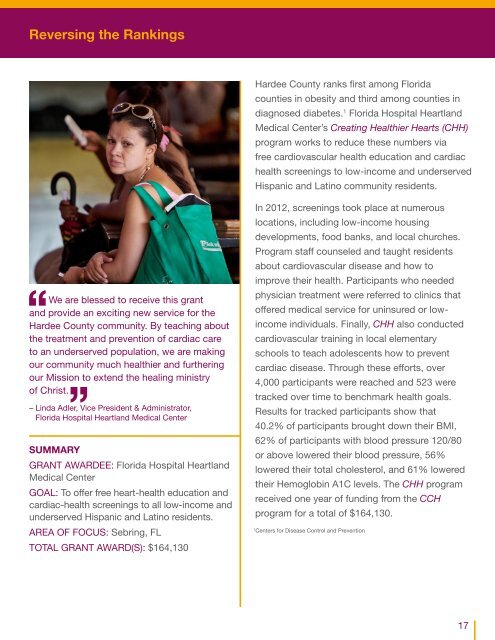Satellite?blobcol=urldata&blobheader=application/pdf&blobheadername1=Content-Disposition&blobheadername2=MDT-Type&blobheadervalue1=inline;+filename=2012-AstraZeneca-HealthCare-Foundation-Annual-Report
Satellite?blobcol=urldata&blobheader=application/pdf&blobheadername1=Content-Disposition&blobheadername2=MDT-Type&blobheadervalue1=inline;+filename=2012-AstraZeneca-HealthCare-Foundation-Annual-Report
Satellite?blobcol=urldata&blobheader=application/pdf&blobheadername1=Content-Disposition&blobheadername2=MDT-Type&blobheadervalue1=inline;+filename=2012-AstraZeneca-HealthCare-Foundation-Annual-Report
Create successful ePaper yourself
Turn your PDF publications into a flip-book with our unique Google optimized e-Paper software.
Reversing the Rankings<br />
Hardee County ranks first among Florida<br />
counties in obesity and third among counties in<br />
diagnosed diabetes. 1 Florida Hospital Heartland<br />
Medical Center’s Creating Healthier Hearts (CHH)<br />
program works to reduce these numbers via<br />
free cardiovascular health education and cardiac<br />
health screenings to low-income and underserved<br />
Hispanic and Latino community residents.<br />
We are blessed to receive this grant<br />
and provide an exciting new service for the<br />
Hardee County community. By teaching about<br />
the treatment and prevention of cardiac care<br />
to an underserved population, we are making<br />
our community much healthier and furthering<br />
our Mission to extend the healing ministry<br />
of Christ.<br />
– Linda Adler, Vice President & Administrator,<br />
Florida Hospital Heartland Medical Center<br />
SUMMARY<br />
GRANT AWARDEE: Florida Hospital Heartland<br />
Medical Center<br />
GOAL: To offer free heart-health education and<br />
cardiac-health screenings to all low-income and<br />
underserved Hispanic and Latino residents.<br />
AREA OF FOCUS: Sebring, FL<br />
TOTAL GRANT AWARD(S): $164,130<br />
In 2012, screenings took place at numerous<br />
locations, including low-income housing<br />
developments, food banks, and local churches.<br />
Program staff counseled and taught residents<br />
about cardiovascular disease and how to<br />
improve their health. Participants who needed<br />
physician treatment were referred to clinics that<br />
offered medical service for uninsured or lowincome<br />
individuals. Finally, CHH also conducted<br />
cardiovascular training in local elementary<br />
schools to teach adolescents how to prevent<br />
cardiac disease. Through these efforts, over<br />
4,000 participants were reached and 523 were<br />
tracked over time to benchmark health goals.<br />
Results for tracked participants show that<br />
40.2% of participants brought down their BMI,<br />
62% of participants with blood pressure 120/80<br />
or above lowered their blood pressure, 56%<br />
lowered their total cholesterol, and 61% lowered<br />
their Hemoglobin A1C levels. The CHH program<br />
received one year of funding from the CCH<br />
program for a total of $164,130.<br />
1<br />
Centers for Disease Control and Prevention<br />
17


